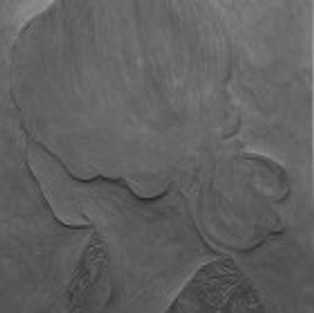
Akihiro Yasugi. Bullet (p)roof • artificial interference. George Billis Gallery. Photo Credit Kristine Schomaker
Straight Shooting Art: Bullet (p)roof at George Billis Gallery
Written by Genie Davis
Closes January 7th
Running through January 7th, Bullet (p)roof – Artificial Interference offers an exciting mix of sculpture, prints, and installation works at the George Billis Gallery. Curated by Kio Griffith and Bryan Ida, this exhibition of five contemporary Japanese artists provides a rich, layered take on technology and humanity.
The artists are Asae Soya, Akihiro Yasugi, Nobuki Mizumoto, Naohiko Onodera, and Sakiko Ohba.
According to Griffith, the show is focused on an investigation into both the user and physical materials involved, working through “scale, color, accuracy and context, transposing the macro to the micro and injecting it vice versa – adapting the sense of touch to feel scalar shifts that the body cannot accomplish on its own – upscaling of human strength to handle hard materials and downscaling of the human touch sense to dial in and sensitively feel the materials.”
All of which sounds complex. But while the art itself is nuanced and compelling, it is entirely as accessible as it is highly tactile.
Griffith notes “The title, Bullet (p)roof • artificial interference, is an analogy of how the world has become a progressively designed dogma under a blue sky of global security that cannot guarantee our livelihood or well-being in an over-capacitated informational labyrinth.” In short, we are protected from nothing, and we need to open ourselves internally and externally to sensation.
Few artists are as sensorial as Asae Soya, whose installation series focuses on light, color, and sensation. The idea behind the works is to express sense-related experiences in a fascinatingly visceral fashion. Soya’s “Bathtub” series lends dimension to the concept that a tub is a place in which physical sensation is felt. From this conceit rose “Ringing Color” and “Ringing Light,” that move into aural and visual sensations where colors and light create sound. Here the artist recreates scenes that she personally experiences while she works, scenes that create these sensations. Her last installation in the exhibition is “Space,” an animation experience.
The works are designed to stimulate visual and physical sensations in viewers, much as Soya’s own art stimulates her own. Bright splashes of color dance like pop-art flowers; a glowing orb of light emanates like a sun through a prism in her “Light 3.” This is an artist whose work has an ethereal, opalescent quality; reminiscent of floating bubbles infused with rays of light and color in some cases, splashes of paint in others.
Akhiro Yasugi’s “Restructuring” seeks to move memories of that artist’s world into a different space. “My memory, memories of the Japanese people” is what his works contain; some fairy-tale-like traditional villages, some apartment skyscrapers, some houses perched and balanced on top of each other, defying gravity. His “Grand Palace” is a vast collection of miniature apartment units visible only from the back of his large scale work; the front appears to be a conventional dresser with a multitude of drawers. This mixed media work conveys the idea that like a series of Russian doll puzzles, there is more inside, behind, within, than meets the eye. Like perfect, witty, delicate doll houses, Yasugi’s sculptural works open the door into the imagination, and “memories into the work that I create… I myself reside in those objects.”
Nobuyuki Mizumoto offers delicate wood, resin, and metal works that are a highly detailed artistic riff on the printing methods of 18th and 19th century Japan. Skewed to contemporary representation, these works nonetheless represent an exceptionally minute, richly created world. Whether the viewer is studying the flower of a human ear in profile, or a pattern of fish and flowers, this unique take on Japanese wood block printing evokes a bygone era of patience and design that spans lifetimes.
Sakiko Ohba’s work similarly plays on traditional Japanese art. Ohba uses copper engravings to express both the past and a dynamic, dream-like future. She uses the technique of “hariko,” paper mache work from Japan’s Edo period in these works, lifting her own two-dimensional images into a slightly surreal, fully dimensional object of art.
Naochiko Onodera’s work is perhaps the darkest of the five artists in the exhibition, perfectly crafted, minute airplanes, machines of war. These are lethal butterflies tethered to a cohesive force, as delicate and floating as they are powerfully calamitous. There is a hopeful, almost toy-like quality to these ominous artistic visions, bringing into focus an inevitable facet of human nature and current affairs. Onodera as an artist is accepting of these issues, and looks to the possibility of creating a new and less threatening world order.
Each of these artists offer fluid work, whether employing traditional Japanese art techniques or utilizing a multi-layered take on sculptural forms or color palette. Viewers will find themselves drawn into a mesmerizing and self-contained world, one that breaks through protective, patriarchal barriers to create a limitless environment of possibility and substance.
#losangeles #art #painting #geniedavis #beverlyhills #chungkingroad #BulletproofArtificialInterference #losangelesart #hollywood #contemporaryart #Japan #southerncalifornia #BryanIda #abstract #collage #photography #artgallery #gallery #culvercity #museum #georgebillisgallery #artopening #NaohikoOnodera #AsaeSoya #assemblage #artexhibition #installation #AkihiroYasugi #fineart #artists #Japaneseartist #artist #soloshow #SakikoOhba #mixedmedia #arts #NobukiMizumoto #sculpture #exhibition #graphite #exhibit #kiogriffith #drawing


































































